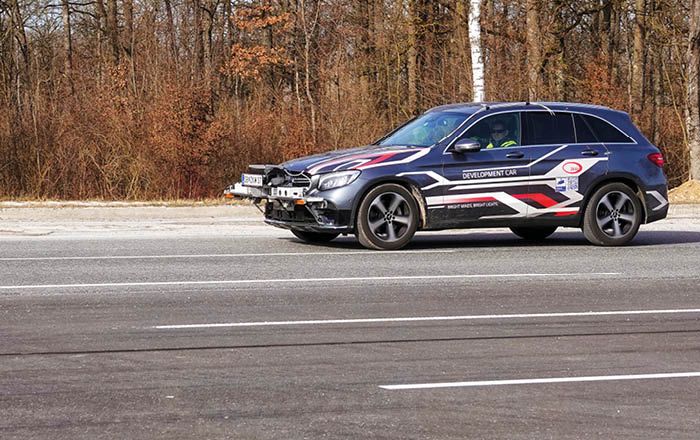Road markings in the age of automated driving
Similarly to human road users, automated and autonomous vehicles use the different lane markings for orientation on the road. SWARCO Road Marking Systems conducts specific research into markings that can best be read by machines.
How can road markings support automated vehicles in everyday traffic? The Center of Competence (CoC), the globally networked research and development department of SWARCO Road Marking Systems, has been working on this important question for an extended period of time. The research team is primarily investigating how different marking systems are perceived by machines. Specifically, the CoC team is investigating which characteristics road markings need to have in order to be perfectly "readable" by the various camera and LiDAR systems in vehicles.

Together with partners (pictured is a test vehicle from automotive supplier ZKW), SWARCO Road Marking Systems is testing how and in which conditions modern vehicle sensors can detect road markings.
Photo: SWARCO Road Marking Systems
Seeing with the machine eye
Machine vision works differently than the visual perception of human road users. Friedrich Wiesinger, Team Leader of Product Development at SWARCO Road Marking Systems, nevertheless sees certain similarities between camera-based systems for automated driving and the human eye based on the research results: "Our research has shown that cameras perceive road markings as well or as poorly as the human eye. Especially in bad weather or difficult lighting conditions, the eye and camera both have their limitations. But this is precisely when high-performance markings can support both man and machine."
LiDAR resists the glare
Drivers are particularly familiar with the difficulty of recognizing road markings when the sun is low or the light from oncoming traffic is causing glare. While this is also a problem for camera-based systems, automotive LiDAR sensors (LiDAR = Light Detection and Ranging) cope better in these situations. This is an important finding from various tests carried out by the Center of Competence. However, further investigations show that LiDAR also has difficulty detecting ground markings in the rain. "As long as the drop-on beads of markings remain above the water surface, the headlight light is reflected back or the laser pulse is reflected by LiDAR and the marking can be detected," explains Wiesinger, also pointing out the advantages of high-performance markings in this context. For example, the drainage effect of textured markings allows water to run off and the marking remains visible for much longer in rain.
The glass bead is the key
In numerous tests, the CoC team and its partners from research and industry are investigating the differences between standard beads and SWARCO SOLIDPLUS & SWARCO DURALUX premium reflective glass beads. "In general, almost all studies have shown that the quality of the glass beads used is a decisive factor," Wiesinger points out an important point. With premium glass beads, for example, road markings can be detected early by machine systems. This time advantage enables vehicles to calculate routes more reliably and increases road safety.
In some countries around the world - for example in the USA and China - legal regulations have already been put in place for the traffic of the future. In Europe, on the other hand, there is currently little movement, as Friedrich Wiesinger also has to acknowledge: "It is a pity that the efforts of the European Union to set uniform standards for road markings on the trans-European road network are currently on hold. Particularly given the fact that vehicles will have to be mandatorily equipped with lane departure warning systems from this year onwards. After all, drivers should be able to use these systems in the best possible way."
Nevertheless, the CoC team and its partners are continuing their research this year into how lane markings can be better detected by sensors in order to increase the reliability of the systems. This is why Friedrich Wiesinger is looking to the future with confidence: "2024 will definitely be an exciting year!"
The research partners in the field of automated driving
SWARCO Road Marking Systems conducts research together with renowned research institutions in Germany, Poland, Croatia and Austria. These include the universities in Aachen, Krakow, Zagreb, Innsbruck, Linz and Graz. In addition, SWARCO Road Marking Systems cooperates with partners from the private sector (e.g. automotive supplier ZKW) and the Austrian Digitrans Test Center. As a member of the Traffic Marking Manufacturers Alliance (TMMA), the company also regularly exchanges information with TMMA President Robert Dingess about current progress in the field of automated driving in the United States.
About SWARCO Road Marking Systems
Quality products and services from SWARCO Road Marking Systems guide traffic safely from A to B by day and, above all, by night. On all types of roads. Whatever the weather. From a single source. Over 5,000 customers in more than 80 countries place their trust in them.
For further information visit: www.swarco.com/rms